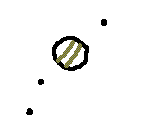Terry liked my "new" binoculars tripod clamp. He confessed that he too often over-engineered things.
We looked at Jupiter and noted, at 9:40 EDT, the position and names of the moons. We returned to Jupiter periodically to note the changes. While it was very low in the horizon at 11:35pm, we made one final sketch. It was hard to see through the glare, light pollution, and clouds.

|
|  |
| 9:40
|
| 11:35
|
Terry also noted the latitude and longitude I had determined from MS Streets and Trips.
We (I should say, they) only saw 2 meteors. The first was at 9:58. It travelled past and below Cygnus to the south-east horizon. The second was from Hercules to Cassiopeia.
We spent the rest of the evening chasing down double stars (as Cindy dusted off her Greek alphabet). At first, I thought it would be fun to look for interesting colour combinations in the constellations off to the west.
We first tried for ε (epsilon) Boötes but could not seem to see anything. Rechecking the notes, we discovered that they were 2.8" apart, which was described, for some other similarly spaced doubles, as difficult. I said, "OK, let's try something that I know: Mizar." We viewed Mizar, the double, at 14", and the nearby Alcor. Terry enjoyed that. I powered up with the 18mm and we liked the increased separation. We agreed to stick to doubles with 10 to 15" separation.
Next we tried for β (beta) Lyra but I had a hard time aiming the 'scope in the straight-up orientation.
So I turned to Polaris (α or alpha Ursa Minor). We could see the very faint second star near to the bright yellow primary star.
Then I reviewed a double-star list looking for interesting subjects first. I came across the famous "Double-Double" in Lyra. So, with Terry's help, I aimed at ε (epsilon) Lyra. At first, I could easily make out the main two "stars" 3.5' apart. But as I looked closer, I could see each was double star. And they were are 90° to the other pair. Wow! Cool.
Terry brought out their 'scope: a Meade 70AZ-A refractor, a 700mm focal length, 70mm aperture, with altazimuth mount. It came with a 9mm and 25mm eyepiece. We talked about tracking issues. Tricky. And it has a mirror diagonal. Still they were thrilled to see Jupiter's moons with it. I pointed out that a small aperture 'scope is better than a larger one for observing Luna.
At some point we talked about averted vision. Useful when splitting doubles.
High clouds were moving in and the mist was rising. We packed up for the evening.
I gave Cindy, Terry, and the boys, a planisphere, a nice one by Firefly, with planet location predictors. We put it to good use tonight.


No comments:
Post a Comment